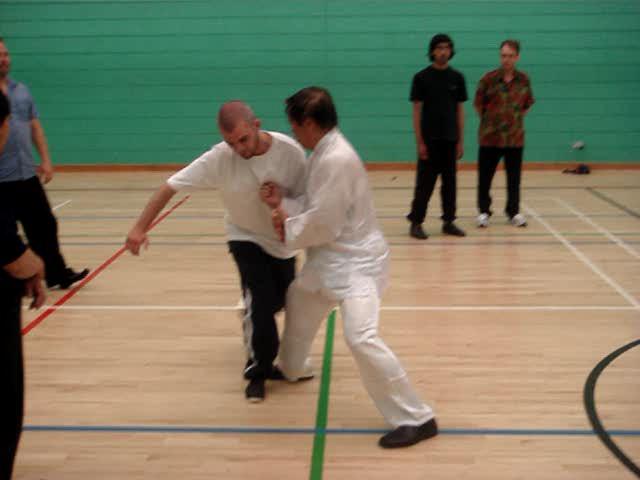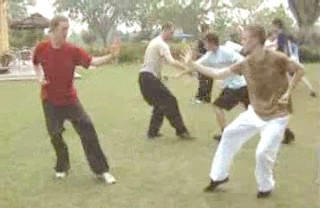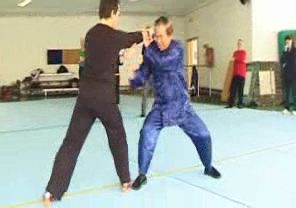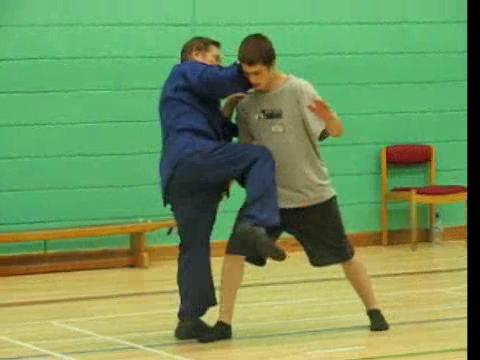SELECTION OF QUESTIONS AND ANSWERS
OCTOBER 2010 PART 1

The Drag Step is an important aspect in this pattern, "Comet Chases Moon"
Question 1
When sparring, whether with Calvin or others, I find that I use the Drag Step a lot. It is odd since it is only found in Shaolin Sequence 5 and is not at all common, not even in the Wahnam Taijiquan sequences..
Unlike our usual footwork with the back leg controlling the move forward, in a drag step, we launch our front leg and body forward and the rest of the body follows. Is this considered a violation of our basic "safety first" principle? If so, how can we effectively guard ourselves when we move in?
— Sifu Zhang Wuji, Singapore
Editorial Note
: Sifu Zhang Wuji's other questions can be found
here
,
here
and
here
.
Answer
The Drag Step is actually a common technique in Shaolin Kungfu, though less in Taijiquan where body-movement is more frequent.
We specifically train the Drag Step in our basic Shaolin set, "Lohan Asks the Way", where after "Immortal Emerges from Cave", we drag forward to execute "Black Tiger Steals Heart". Besides Shaolin Combat Sequence 5, it is also found in Combat Sequence 4. In Taijiquan Combat Sequence 8, we may use a Drag Step to bridge a gap in the palm strike after avoiding a sweeping kick using "Low Stance Single Whip".
Although the Drag Step is a common footwork technique, it is not formally included in combat sequences because its application is due to expedient needs. In other words, the formal pattern may be a strike in a Bow-Arrow Stance, but if an opponent happens to be slightly far away in that situation, we add a Drag Step to bridge the gap.
In a Drag Step the back leg also controls the body movement although we move the front leg forward. For example, I am at a right Bow-Arrow Stance and about to apply a right hand strike. But at that moment the opponent shifts his body slightly backward with the result that my intended strike might not reach him.
I focus my body weight on my back left leg and move my front right leg slightly forward. My body slants backward so that if the opponent strikes me at this time, he could not reach me. If his strike is too penetrating, as my weight is still on my back leg, I can bring my front right leg backward to a right False-Leg Stance or even further to a right T-Step (Ding Bu). When everything is safe, I shift my body forward dragging my back leg forward too, and strike the opponent with my right hand as I settle to a right Bow-Arrow Stance. The description here is lengthy, but with practice the movements, including any adjustments, can be very fast.
Hence, the Drag Step is not throwing the body forward, which would be a deviation of our basic "safety first" principle as you have mentioned, though when the gross movements are minimized, it may appear to be so. Nevertheless, in exceptional cases where safety is assured, one may launch the body forward for speed.
What should you do in such cases if an opponent counter-strikes? You can stop or intercept his attack with a "taming hand".
Question 2
I was reviewing a couple of videos from my Special and Advanced Courses the other night, and I found that I had not been practicing the counters against more exotic or at least less common attacks.
The little time I have is spent on my basic sequences and dealing with boxers and kick-boxers. I have not gone to dealing with Muay Thai attacks, grips and wrestling yet. One reason is because I believe that the basic 16/12 sequences could allow me to handle even such attacks.
Answer
You are right. Indeed the 16 basic Shaolin combat sequences and the 12 basic Taijiquan sequences are composed for this purpose, i.e. handling all forms of attacks.
We should spend time mastering these sequences first, because when we can perform them well, unless thr attacks are very special or sophisticated. we will be able to counter correctly no matter what attacks our opponents may use, including attacks from Boxing, Kick-Boxing, Muay Thai and other martial arts.
This does not mean we can defeat all our opponents. If our opponents are more skillful, even when we know the counters against their simple techniques, they can still beat us.
When we have mastered the basic combat sequences which enable us to handle all attacks in general, we progress to advanced combat sequences derived from specialized sets which deal with advanced and sophisticated attacks. In today's sparring, the standard of techniques used is quite low compared to that in the past. Most martial artists do not know how to deal with such sophisticated attacks.
In other words, if you attack most opponents with punches and kicks, they would be able to defend against your attacks. But if you use sophisticated techniques like felling and qin-na, many of them would not know how to respond.
Again we must remember that this does not mean we can defeat our opponents. If our opponents are more skillful, like faster or more powerful, they will defeat us even when they use only simple techniques. But if the skills are of similar levels, our opponents would be quite helpless when we apply sophisticated techniques on them.
There are pros and cons in our teaching approach. Because we have so many techniques and skills, and our students are spread all over the world, I choose to teach via regional, intensive and special courses lasting only a few days per course. Students learn in a few days what they can spread over a year or two to practice.
The great advantage is that our students are able to have a lot of useful material in a short time. The disadvantage is that if they don't practice on their own, they may know a lot of techniques but do not have sufficient skills to apply them effectively. They would be victims of the famous kungfu saying, "lian quan bu lian gong, tau lao yi chang kong", which is "if you only learn techniques but never train force (or develop skills), you will be futile even if you train for a life-time".
The regular classes taught by our certified instructors can help to overcome this problem if conducted properly.

Many people may find it hard to believe, but if you are well trained in the basic 16 Shaolin Combat Sequences you can handle any forms of attack
Question 3
But in one of the commentaries for the Special Course, Sifu explained that:
"Like other techniques, you must practice the counter many times to be fluent, so that when the occasions arise to use it, you can apply it spontaneously and correctly. Steve tries to use other counters against the grab head elbow strike, but they are not effective. This shows that one must have the counter ready beforehand. It would be too late to try working out a counter during actual combat."
Answer
This is very good advice. In fact a main reason why most kungfu practitioners today cannot use kungfu in sparring is because they are ignorant of this advice, or if they know it, they do not know how to apply it systematically.
A common mis-conception many kungfu practitioners have is that when an opponent attacks in a certain way, they quickly think out one of the many patterns they have learnt which they they can use to counter the attack. Of course this doesn't work. By the time he has thought of a good counter, he would be hit many time.
During fighting, or even friendly sparring, there is no time to think, unless the combatant is a master where in a moment of Zen, perception of time slows down for him. The thinking has been done by him earlier, or usually by his teacher or generations of masters before him. This prior thinking results in effective combat sequences. Hence, by practicing these combat sequences we prepare ourselves to react correctly and spontaneously when attacked.
Question 4
I therefore felt I should start on some of the more esoteric counters against less common attacks now. May I have Sifu's advice on the best way to train them at this point . Is it more cost-effective to practice the techniques in a special sequence of esoteric counters, or would I have better results by training each technique on its own? I was thinking of devoting maybe 5% of my total training time for this area. Is that sufficient?
Answer
We should be good at the basics before mastering specialized techniques. This does not mean that we cannot attempt specialized techniques before mastering the basics, or still practice the basics even after having started specialized techniques. The tenet is meant as a general guideline, not as a dogmatic doctrine.
For example, if an opponent attacks with a thrust punch, leaning on the punch with "Single Tiger" and immediately countering with a "Black Tiger" is a basic response in Shaolin Kungfu. If he executes a side kick, moving back diagonally and simultaneously striking the kicking leg with "Lohan Strikes Drum" is a basic response.
There are various specialized responses depending on the specialized sets you have chosen. In the Tiger-Crae Set, an example each of a specialized respond will be "Single-Leg Hungry Crane", and "Hungry Tiger Leaning on Wooden Door" respectively.
Swallow the opponent's thrust punch and hook his punching arm with one crane-beak, strike his eye with the other beak which can be a real or a feign attack, and simultaneously kick at his groin. In the counter against a side-kick, sinks back as he kicks and trap his kicking leg with two Tiger-Claws. Immediately move in for the coup de grace.
In Taijiquan, a basic respond each to the thrust punch is to ward off with "Immortal Waves Sleeves", then counter-strike with "White Snake Shoots Venom". A basic counter to a side kick is "Striking Tiger Poise".
You can choose a few patterns from Taijiquan to make them into specialized counters againt the punch and the kick. An example is "Old Eagle Catches Snake" to grip the opponent's arm as he punches. As he kicks, shift back your body or leg to avoid the attack, and immediately move forward to fell him onto the ground with "Carry Tiger Back to Mountain".
It is obvious that the opponent will have more difficulty defending our specialized counters than our basic counters. Then, why do we spend time mastering the basic counters first? There are a few good reasons as follows.
The basic counters are our "bread and butter" for combat. As they are capable of countering a more comprehensive range of attacks than specialized counters do, we can always fall back on them whenever necessary.
The basic counters are easier to perform, as they fulfill the important principle of "safety first". We rather be safe though we may miss hitting the opponent than risking our safety performing more sophisticated movements though the chance of hitting the opponent is higher.
Practicing the basic counters train our basic skills, which will later make it easier for us to perform specialized counters. This enables us to start later but arrive earlier.
Even when we are equally skillful in our specialized counters, there may be occasions when applying basic counters is preferred. One occasion is when an opponent may want to trick us. Using basic counters will avoid falling into his trap.
Another occasion is the reverse, when we want to trick our opponent. We purposely slow down and pretend to be prosaic in our responses. Then we surprised him with a sophisticated counter.
By now you should be proficient in your basic counters. A good guideline is how you spar with black-belts. If you can handle them competently with your basic counters, you can progress to specialized counters. You may not even need a live partner to practice with. Practice you specialized counters with an imaginary opponent 30 times a day for three months. Then, when you apply them in sparring or real fighting, you will be surprised how easily you can subdue your opponents.
Of course practicing sequences is more effective than practicing individual techniques. You should also practice modifications and adjustments of your specialized sequences. Sequence sparring is one level above technique sparring, which in turn is one level above random sparring, which most martial artists do today.

Similarly, the basic 12 Taijiquan Combat Sequences are composed for the same purpose, i.e. enabling practitioners to handle all forms of attack
Question 5
I would like to ask you about non-thought. What does it means?
— Tony, USA
Answer
Non-thoughts means no thoughts arise in one's mind. In other words, his mind is clear of all thoughts.
Due to some odd reasons, probably their habit of intellectualziation, some people are worried of non-thoughts. They wrongly believe that if there areno thoughts, they may become morons. This, of course, is not true. In fact, if they attain non-thoughts, they have pristine mental clarity.
Question 6
.All my thoughts abide in non-thought naturally without effort.
Answer
This statement is incorrect. Non-thoughts means there are no thoughts. When your thoughts abide, you have thoughts, which is the opposite of non-thoughts.

In our school we have many counters against Muay Thai attacks, such as this knee jab
Question 7
Does this mean that I'm enlightened?
Answer
No, you are not Enlightened. You are also not enlightened.
Notice the difference between "Enlightenment" with a capital "E", and "enlightenment" with a small "e".
The term "Enlightenment" with a capital "E" is often mis-understood. It refers to the highest spiritual fulfillment, where there are no thoughts and no differentiation into countless entities. The Enlightened person is completely integrated with the Supreme Cosmic Reality. In Western terms, he returns to God the Holy Spirit.
The term "enlightenment" with a small "e" refers to a mental state where one understands the reasoning behind the topic in question. This involves thoughts. For example, before I answered your question, you did not understand what was non-thoughts. After my explanation, you understand very well. Thus, you are enlightened on what non-thoughts is.
Question 8
If not, what is the next step that I should proceed to realize perfect enlightenment? Actualizing enlightenment is my dream as a householder. So what's next after attaining non thought?
Answer
You have a very long way to go in reaching perfect Enlightenment.
First of all you must understand what Enlightenment mean. Read and understand my book, "The Complete Book of Zen", which will give you a good idea what Enlightenment is, how to cultivate towards its realization and the various steps on the way.
While attaining non-thought is a necessary requirement for attaining Enlightenment, non-thought alone is not Enlightenment. Even when one attains non-thought, there is still a very, very long way to go before he can attain Enlightenment, though Enlightenment itself is some form of Supreme Non-Thought.
Indeed, the Sixth Patriarch, Hui Neng, teaches that when thoughts do not arise, one attains Enlightenment. Superficially this may suggest that non-thought is Enlightenment, but it is not. It is not a contradiction; it is just that words are inadequate to describe such a profound concept as Enlightenment.
As a rough mundane analogy, having money is a necessary requirement for becoming wealthy. Becoming wealthy is having a lot of money. Yet, even when one has money, there is still a long way for him to go before he becomes wealthy.
LINKS
Selected Reading
- Getting the Best Benefits from your Training
- Great Kungfu is a Process of Spiritual Cultivation
- Seeing things Clearly and in a Completely Different Way
- Forte of Shaolin against Weakness of Boxing
- Overwhelming Opponents with Sequence Sparring
